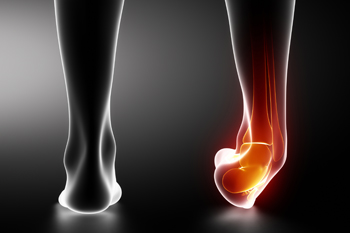Connect With Us
Blog
Items filtered by date: September 2025
Peripheral Arterial Disease and Its Impact on the Feet

Peripheral arterial disease is a condition where the arteries that carry blood to the legs and feet become narrowed. When circulation is reduced, the feet may feel cold, wounds may heal very slowly, and walking can cause cramping or pain. The skin can sometimes appear pale, shiny, or thin due to the lack of proper blood flow. In more advanced stages, ulcers or sores may develop, which can be difficult to treat without medical attention. Lifestyle factors such as smoking, high cholesterol, and diabetes can increase the risk of this condition. Maintaining healthy habits, staying active, and protecting the feet from injury are all important for prevention. If you notice persistent leg pain, non-healing wounds, or changes in skin color, it is suggested that you seek evaluation from a podiatrist to receive timely and appropriate treatment.
Peripheral artery disease can pose a serious risk to your health. It can increase the risk of stroke and heart attack. If you have symptoms of peripheral artery disease, consult with one of our podiatrists from Foot & Ankle Medical Center . Our practitioners will assess your condition and provide you with quality foot and ankle treatment.
Peripheral artery disease (PAD) is when arteries are constricted due to plaque (fatty deposits) build-up. This results in less blood flow to the legs and other extremities. The main cause of PAD is atherosclerosis, in which plaque builds up in the arteries.
Symptoms
Symptoms of PAD include:
- Claudication (leg pain from walking)
- Numbness in legs
- Decrease in growth of leg hair and toenails
- Paleness of the skin
- Erectile dysfunction
- Sores and wounds on legs and feet that won’t heal
- Coldness in one leg
It is important to note that a majority of individuals never show any symptoms of PAD.
Diagnosis
While PAD occurs in the legs and arteries, Podiatrists can diagnose PAD. Podiatrists utilize a test called an ankle-brachial index (ABI). An ABI test compares blood pressure in your arm to you ankle to see if any abnormality occurs. Ultrasound and imaging devices may also be used.
Treatment
Fortunately, lifestyle changes such as maintaining a healthy diet, exercising, managing cholesterol and blood sugar levels, and quitting smoking, can all treat PAD. Medications that prevent clots from occurring can be prescribed. Finally, in some cases, surgery may be recommended.
If you have any questions, please feel free to contact our offices located in Nampa and Fruitland, ID . We offer the newest diagnostic and treatment technologies for all your foot care needs.
Injuries That Cause Foot Pain in Runners
 The feet are made up of a variety of bones, tendons and ligaments, and running can put stress on any them. While runners can experience different minor issues with the feet, there are many issues that can lead to severe pain and sideline a runner. One common cause of foot pain in runners is plantar fasciitis. This occurs when the plantar fascia ligament that runs along the bottom of the foot becomes inflamed, leading to heel pain. Stress fractures, which are hairline fractures in the bones of the feet, are also common among runners. Runners should also be aware of extensor tendonitis, which results in the inflammation of the tendons that help with the movement of the toes. A tight abductor or adductor hallucis, both muscles that help with movement of the feet, can lead to debilitating pain as well. If you are a runner and you notice severe pain in your feet, it is suggested that you make an appointment podiatrist for a diagnosis and treatment.
The feet are made up of a variety of bones, tendons and ligaments, and running can put stress on any them. While runners can experience different minor issues with the feet, there are many issues that can lead to severe pain and sideline a runner. One common cause of foot pain in runners is plantar fasciitis. This occurs when the plantar fascia ligament that runs along the bottom of the foot becomes inflamed, leading to heel pain. Stress fractures, which are hairline fractures in the bones of the feet, are also common among runners. Runners should also be aware of extensor tendonitis, which results in the inflammation of the tendons that help with the movement of the toes. A tight abductor or adductor hallucis, both muscles that help with movement of the feet, can lead to debilitating pain as well. If you are a runner and you notice severe pain in your feet, it is suggested that you make an appointment podiatrist for a diagnosis and treatment.
Ankle and foot injuries are common among athletes and in many sports. They can be caused by several problems and may be potentially serious. If you are feeling pain or think you were injured in a sporting event or when exercising, consult with one of our podiatrists from Foot & Ankle Medical Center . Our practitioners will assess your condition and provide you with quality foot and ankle treatment.
Common Injuries
The most common injuries that occur in sporting activities include:
- Achilles Tendonitis
- Achilles Tendon Rupture
- Ankle Sprains
- Broken Foot
- Plantar Fasciitis
- Stress Fractures
- Turf Toe
Symptoms
Symptoms vary depending upon the injury and in some cases, there may be no symptoms at all. However, in most cases, some form of symptom is experienced. Pain, aching, burning, bruising, tenderness, tightness or stiffness, sensation loss, difficulty moving, and swelling are the most common symptoms.
Treatment
Just as symptoms vary depending upon the injury, so do treatment options. A common treatment method is known as the RICE method. This method involves rest, applying ice, compression and elevating the afflicted foot or ankle. If the injury appears to be more serious, surgery might be required, such as arthroscopic or reconstructive surgery. Lastly, rehabilitation or therapy might be needed to gain full functionality in the afflicted area. Any discomfort experienced by an athlete must be evaluated by a licensed, reputable medical professional.
If you have any questions please contact our offices located in Nampa and Fruitland, ID . We offer the newest diagnostic and treatment technologies for all your foot and ankle needs.
Inspect Your Feet Regularly for Abnormalities if You're Diabetic
When the Outer Ankle Bone Breaks

A fracture of the lateral malleolus involves the bony prominence on the outside of the ankle. Symptoms often begin with sudden pain following an injury, such as twisting the ankle or a direct impact. Swelling and bruising usually develop quickly, and bearing weight may be extremely difficult. Some people notice instability or tenderness along the outer ankle, while others may even see a visible change in alignment. Because these signs can resemble a severe sprain, imaging is often required to confirm the injury. Treatment depends on the extent of the fracture and the stability of the joint. Simple breaks may be treated with immobilization and gradual return to activity, while more serious cases can require surgery to restore proper alignment. Targeted exercising is often part of recovery. If you suspect an ankle fracture, it is suggested that you promptly consult a podiatrist who can accurately diagnose and treat this condition.
Broken ankles need immediate treatment. If you are seeking treatment, contact one of our podiatrists from Foot & Ankle Medical Center . Our practitioners can provide the care you need to keep you pain-free and on your feet.
Broken Ankles
A broken ankle is experienced when a person fractures their tibia or fibula in the lower leg and ankle area. Both of these bones are attached at the bottom of the leg and combine to form what we know to be our ankle.
When a physician is referring to a break of the ankle, he or she is usually referring to a break in the area where the tibia and fibula are joined to create our ankle joint. Ankles are more prone to fractures because the ankle is an area that suffers a lot of pressure and stress. There are some obvious signs when a person experiences a fractured ankle, and the following symptoms may be present.
Symptoms of a Fractured Ankle
- Excessive pain when the area is touched or when any pressure is placed on the ankle
- Swelling around the area
- Bruising of the area
- Area appears to be deformed
If you suspect an ankle fracture, it is recommended to seek treatment as soon as possible. The sooner you have your podiatrist diagnose the fracture, the quicker you’ll be on the way towards recovery.
If you have any questions, please feel free to contact our offices located in Nampa and Fruitland, ID . We offer the newest diagnostic and treatment technologies for all your foot care needs.
Relief Methods for Plantar Fasciitis

Plantar fasciitis develops when the thick band of tissue on the bottom of the foot, known as the plantar fascia, becomes strained and inflamed. This tissue supports the arch and helps absorb impact with each step. When it is irritated, pain is often felt near the heel, especially with the first steps in the morning. A podiatrist can provide an accurate diagnosis and suggest treatments that reduce pressure on the fascia. Supportive shoe inserts, shoes that provide adequate arch support, and custom orthotics may be recommended or prescribed. In addition, stretching exercises to improve flexibility in the Achilles tendon, calf muscles, and the plantar fascia itself can help restore normal foot mechanics and lessen discomfort. Taping or night splints may also be used to keep the foot in a stable position while healing. If you are experiencing foot or heel pain as the result of plantar fasciitis, it is suggested that you schedule an appointment with a podiatrist for effective treatment.
Plantar fasciitis can be very painful and inconvenient. If you are experiencing heel pain or symptoms of plantar fasciitis, contact one of our podiatrists from Foot & Ankle Medical Center . Our practitioners can provide the care you need to keep you pain-free and on your feet.
What Is Plantar Fasciitis?
Plantar fasciitis is the inflammation of the thick band of tissue that runs along the bottom of your foot, known as the plantar fascia, and causes mild to severe heel pain.
What Causes Plantar Fasciitis?
- Excessive running
- Non-supportive shoes
- Overpronation
- Repeated stretching and tearing of the plantar fascia
How Can It Be Treated?
- Conservative measures – anti-inflammatories, ice packs, stretching exercises, physical therapy, orthotic devices
- Shockwave therapy – sound waves are sent to the affected area to facilitate healing and are usually used for chronic cases of plantar fasciitis
- Surgery – usually only used as a last resort when all else fails. The plantar fascia can be surgically detached from the heel
While very treatable, plantar fasciitis is definitely not something that should be ignored. Especially in severe cases, speaking to your doctor right away is highly recommended to avoid complications and severe heel pain. Your podiatrist can work with you to provide the appropriate treatment options tailored to your condition.
If you have any questions, please feel free to contact our offices located in Nampa and Fruitland, ID . We offer the newest diagnostic and treatment technologies for all your foot care needs.
Why Posterior Tibial Tendon Trouble Changes Your Walk

Posterior tibial tendinopathy is a condition that affects the tendon running along the inside of the ankle and foot. This tendon supports the arch, so when it becomes weakened or inflamed, pain and swelling often appear on the inner ankle. Over time, the arch may begin to flatten, leading to instability and difficulty walking long distances. Many people notice aching after standing for long periods of time, or pain that worsens with physical activity. The condition often develops from overuse, poor foot mechanics, or injuries that strain the tendon. Without treatment, it can progress to adult-acquired flatfoot, making daily movement more challenging. Treatment includes rest, supportive footwear, and custom orthotics to reduce strain. Targeted stretching and strengthening exercises are also helpful. If symptoms persist or the tendon becomes severely damaged, surgical options may be considered to restore proper foot function. If you have painful arches, it is suggested that you see a podiatrist for a proper diagnosis and appropriate treatment.
Ankle pain can have many different causes and the pain may potentially be serious. If you have ankle pain, consult with one of our podiatrists from Foot & Ankle Medical Center . Our practitioners will assess your condition and provide you with quality foot and ankle treatment.
Ankle pain is any condition that causes pain in the ankle. Due to the fact that the ankle consists of tendons, muscles, bones, and ligaments, ankle pain can come from a number of different conditions.
Causes
The most common causes of ankle pain include:
- Types of arthritis (rheumatoid, osteoarthritis, and gout)
- Ankle sprains
- Broken ankles
- Achilles tendinitis
- Achilles tendon rupture
- Stress fractures
- Tarsal tunnel syndrome
- Plantar fasciitis
Symptoms
Symptoms of ankle injury vary based upon the condition. Pain may include general pain and discomfort, swelling, aching, redness, bruising, burning or stabbing sensations, and/or loss of sensation.
Diagnosis
Due to the wide variety of potential causes of ankle pain, podiatrists will utilize a number of different methods to properly diagnose ankle pain. This can include asking for personal and family medical histories and of any recent injuries. Further diagnosis may include sensation tests, a physical examination, and potentially x-rays or other imaging tests.
Treatment
Just as the range of causes varies widely, so do treatments. Some more common treatments are rest, ice packs, keeping pressure off the foot, orthotics and braces, medication for inflammation and pain, and surgery.
If you have any questions please feel free to contact our offices located in Nampa and Fruitland, ID . We offer the newest diagnostic tools and technology to treat your foot and ankle needs.

